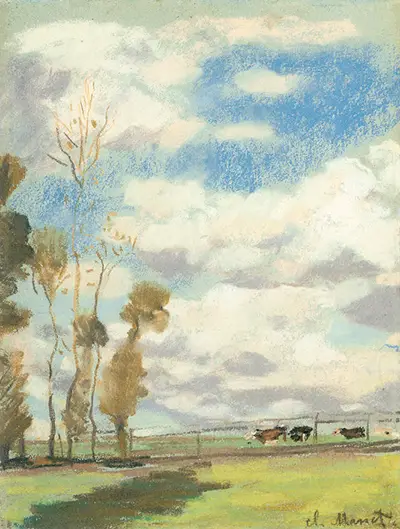Pastel medium allowed artists to balance between simplicity and the high cost of painting bright oil paint colours using plein air.
Monet was known for taking different locations while creating most of his works; often the outdoors.
In this painting, Claude creates the piece that illustrates pasture land with three cows grazing afar off. Though it is a pastel piece, he doesn't shy off from using characteristic painting style of emphasising the weather at the time. In this case, it is a little cloudy. He uses a drab green colour to highlight the pastureland.
A 1984 scholarly by Genevieve Monnier about pastels created between the 16th and 20the century showed that Monet drew only a few pastels during his time.
Now dubbed The Unknown Monet the pastel works created by Monet illustrated the most intense and reserved side of his life. Monet's pastel works produced as drafts for paintings featured between the years 1878 and 1885. The paintings reveal his suffering and worrying financial status as it was then that Monet had lost his life.
For a long time, Claude allowed other artists and fans to believe that he rarely used pastels to draft out actual paintings like Morisot or explore subsidiary features for larger designs like Degas. Being an Impressionist, Monet wanted to be known as plein-air painter and an artist who painted his subjects straight from nature.
It was this perception that prevented art museums from displaying his pastels along with other popular paintings. In the 1987 exhibition at the Arts Council of Great Britain, The Private Degas' works were displayed, which included pastels. Recent exhibitions of Mary Cassatt and Berthe Morisot also incorporated pastels within their oeuvre.
For Monet, however, pastels were mere extensions to his pictorial catalogue and exact representations of the real world. This renowned painter was known for carrying a sketchbook wherever he went. He highlighted that the notebook pages provided a private space for him to write ideas, and the practical drawings were not aesthetic entities.
Monet's attitude towards pastels was even more startling as he gifted close friends and colleagues with them. He also sold the pastels to people who could buy a painting.
However, further studies about Monet's working techniques found that Monet's attitude towards pastels was a result of the ill will to this medium then. It was evident as popular exhibitions The Seine and the Sea displayed up to 70 of Monet’s creations that were painted between 1878 and 1883.
This was close to the same period that The Unknown Monet series was created using similar subjects yet not acknowledged. Being a Poignant, pieces like the Etretat, the Needle Rock, and Porte d’Aval featured in this oeuvre with James Wildenstein revealing Monet worked on close to 108 pastels. James Whistler was another significant artist who used pastels.
Artists who adopted this painting style often relied on pastels as a medium they used to record fresh ideas before creating the actual painting. Pastels also allowed them to record the fleeting effects of light, the excitement of visual sensations and the fresh colours of nature.
It was this process that helped Impressionists study the fragility of texture coupled with the evanescence of sense perceptions.
Eugene Boudin, for example, had anticipated the new way of drawing the fleeting light effects in the 1850s, twenty years before Claude painted Impression Sunrise using pastels. James McNeill Whistler, another famous artist, had been commissioned to create twelve etchings in Venice in 1879 within three months.
Instead, James remained in Venice for fourteen months after creating the required etchings along with a collection of pastels. 53 pieces of these pastels were later displayed at the Fine Arts Society in London.


